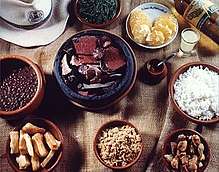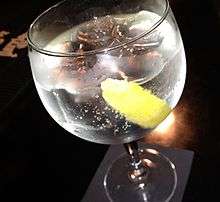Cocktails with cachaça
There are many cocktails made with cachaça, the national spirit of Brazil. Caipirinha is by far the most popular and internationally well-known.[1]
 |
| Part of a series on |
| Brazilian cuisine |
|---|
| Types of food |
| See also |
|
Caipirinha
| IBA official cocktail | |
|---|---|
| Type | Cocktail |
| Primary alcohol by volume | |
| Served | On the rocks; poured over ice |
| Standard garnish | lime[2] |
| Standard drinkware |  |
| IBA specified ingredients | |
| Preparation | Place lime and sugar into old fashioned glass and muddle (mash the two ingredients together using a muddler or a wooden spoon). Fill the glass with crushed ice and add the Cachaça.[3] |
| Notes | A wide variety of fresh fruits can be used in place of lime. In the absence of cachaça, vodka can be used, making a caipiroska.[4] If rum is used instead of cachaça it is called a caipiríssima [5], while the use of sake makes it a sakerinha [6]. |
The Caipirinha is Brazil's national cocktail made with cachaça, ice, sugar, and lime. It is the drink most commonly associated with cachaça.
In Brazil, other versions of caipirinha are made with different alcoholic beverages or fruits. A caipiroska or caipivodka is made with vodka instead of cachaça, while a caipiríssima is made with rum and a sakerinha, with sake [7]. Different from the mojito, the caipiríssima is made with crushed lime (not lime juice), and has no mint or soda water. If other fruit is used instead of lime, it is usually called a batida or caipifruta.
Batida
| Cocktail | |
|---|---|
| Type | Cocktail |
| Primary alcohol by volume | |
| Served | On the rocks; poured over ice |
| Commonly used ingredients | |
| Preparation | Mix and pour into chilled glass. |
Batida is a Brazilian cocktail made with the national alcoholic drink cachaça. In Portuguese, batida means shaken or milkshake. It is made with cachaça, fruit juice (or coconut milk), and sugar. It can be blended or shaken with ice.
In Rio de Janeiro and São Paulo, batidas are traditionally served with feijoada.
A variation is made adding sweet condensed milk or sour cream.
The most common fruit used in a Batida are lemon, passion fruit and coconut.
Rabo-de-galo
Rabo-de-galo, which means "cock tail" (in Brazilian Portuguese cocktail is called coquetel), is a Brazilian drink made of cachaça and red vermouth. The history of the Rabo de Galo dates back to 1950s and the inauguration of the Cinzano factory in São Paulo[8], it is also known as Traçado, the Portuguese word for mixed. Alternatively, is known as a mixture of "everything you have in the bar" in some places. It is questionable whether the proportions in rabo-de-galo have ever been formally established. Most bartenders will simply "eyeball" the two ingredients, adjusting the proportions to the customer's taste. A quite common version calls for 2/3 of cachaça and 1/3 of vermouth. Rabo-de-galo is usually served straight up in large shot glasses. A popular variation in São Paulo, Brazil substitutes the vermouth with Cynar, an Italian bitter apéritif liqueur flavored with artichoke.
Caju Amigo (Friendly Cashew)
| Cocktail | |
|---|---|
| Type | Cocktail |
| Primary alcohol by volume | |
| Served | Neat; undiluted and without ice |
| Standard garnish | Slice of cashew |
| Standard drinkware | |
| Commonly used ingredients |
|
| Preparation | The slice is placed on the tongue and chased by the shot of cachaça. Or the two ingredients are mixed in a shot glass and served straight. |
Caju Amigo, also known as Cajuzinho (Little Cashew), is a Brazilian drink made of cachaça and cashew juice. In some places, a slice of cashew is put in the drinker's mouth with a little bit of salt, chewed without swallowing, and a shot of cachaça is thrown back straight- swallowing the fruit and the drink at the same time.
Quentão (Hot Stuff)
| Cocktail | |
|---|---|
| Type | Cocktail |
| Primary alcohol by volume | |
| Served | Hot |
| Standard garnish | citrus peel |
| Standard drinkware | |
| Commonly used ingredients | |
| Preparation | caramelize the sugar with the spices and peels, then add the liquids. Boil for a few minutes then serve hot. |
Quentão, which means "very hot" or "big hot one", is a hot Brazilian drink made of cachaça and spices. It is often served during the celebrations known as Festas Juninas. The sugar is first caramelized with spices (whole cloves, cinnamon sticks and ginger chunks) and citrus peels (orange and lime). This mixture is then boiled with water for 10 minutes. The cachaça is added and boiled for another 5 minutes.
It is very common in southernmost parts of Brazil to use red wine instead of cachaça, the primary ingredient of Quentão, since this region is the largest wine producer in Brazil.
As the name suggests, it's meant to be served hot - ideally to be served outside on social gatherings on cold nights, near a fireplace. The ginger also adds to the sensation of warmth in the drink. The gingery flavor should be very distinctive, high notes of cloves must be present also. Nutmeg is an optional ingredient, used in some recipes.
Leite de Onça (Jaguar Milk)
| Cocktail | |
|---|---|
| Type | Cocktail |
| Primary alcohol by volume | |
| Served | Neat; undiluted and without ice |
| Standard garnish | cinnamon or chocolate (optional) |
| Standard drinkware | mug (preferably a non-transparent one) |
| Commonly used ingredients |
|
| Preparation | mix the condensed milk and the milk until they blend together. Add cachaça and let it rest. Add cocoa licor when it's ready to serve |
Leite de onça (Jaguar milk) is a cold Brazilian drink made of cachaça and condensed milk. It is very sweet and has a very suave scent that evokes the homely atmosphere of a Festa Junina. It is not easy to replace the ingredients and achieve a similar result because its taste is very peculiar.
It is usually served cold, in plain mugs, without garnish (though often cinnamon or chocolate powder is sprinkled over) so that it looks like milk at a first glance.
Macunaíma
| Cocktail | |
|---|---|
| Type | Cocktail |
| Primary alcohol by volume | |
| Served | Straight up; without ice |
| Standard drinkware |  |
| Commonly used ingredients |
|
| Preparation | Shake and strain into an Americano glass |
The Macunaíma is a cocktail made with cachaça, sugar syrup, lime, and Fernet-Branca. It is shaken and served straight up in a "barriquinha", americano glass (a traditional Brazilian glass), or an old fashioned glass. Created by Arnaldo Hirai from Boca de Ouro bar in 2014, it is named after the famous novel Macunaíma by Mário de Andrade [9].
Royce (Shaken)
| Cocktail | |
|---|---|
| Type | Mixed drink |
| Primary alcohol by volume | |
| Served | rocks x |
| Standard drinkware | |
| Commonly used ingredients |
|
| Preparation | In a mixing glass, mix sugar and fruit slices and press to juice fruit, add ice, guava juice and cachaça, mix again - pour into tall glass. |
| This cocktail was invented at Liberty Bar in Seattle, Washington in honor of Royce Gracie. | |
Royce is an American cocktail made with the Brazilian national spirit cachaça. This cocktail was named in honor of Royce Gracie, a great Brazilian jiu-jitsu fighter.
References
- Simonson, Robert (July 10, 2012). "Cachaça: Beyond a One-Note Samba". The New York Times. ISSN 0362-4331. Archived from the original on February 13, 2020. Retrieved 2020-02-15.
- Lula da Silva, Luiz Inácio. "Decreto N° 4.851, de 2 de Outubro de 2003". Senado Federal Subsecretaria de Informações. Archived from the original on 2012-02-24. Retrieved 2011-07-14.
- "Caipirinha Recipe". Caipirinha Cocktail. Archived from the original on 2010-06-12.CS1 maint: unfit url (link)
- "Brazilian Drinks: Caipirinha". Maria's Cookbook. Maria-Brazil.org. Retrieved 2019-09-26.
- pt:Caipiríssima
- "Strawberry Sakerinha Recipe". The Blind Taste. Retrieved 2020-06-11.
- "Strawberry Sakerinha Recipe". The Blind Taste. Retrieved 2020-06-11.
- "BBMAG | Rabo de Galo: a new classic". BBMAG | Bossa Brazil Magazine. 2020-04-29. Retrieved 2020-05-14.
- "Macunaíma, drinque clássico do Boca de Ouro". mixologynews. Retrieved April 7, 2020.
